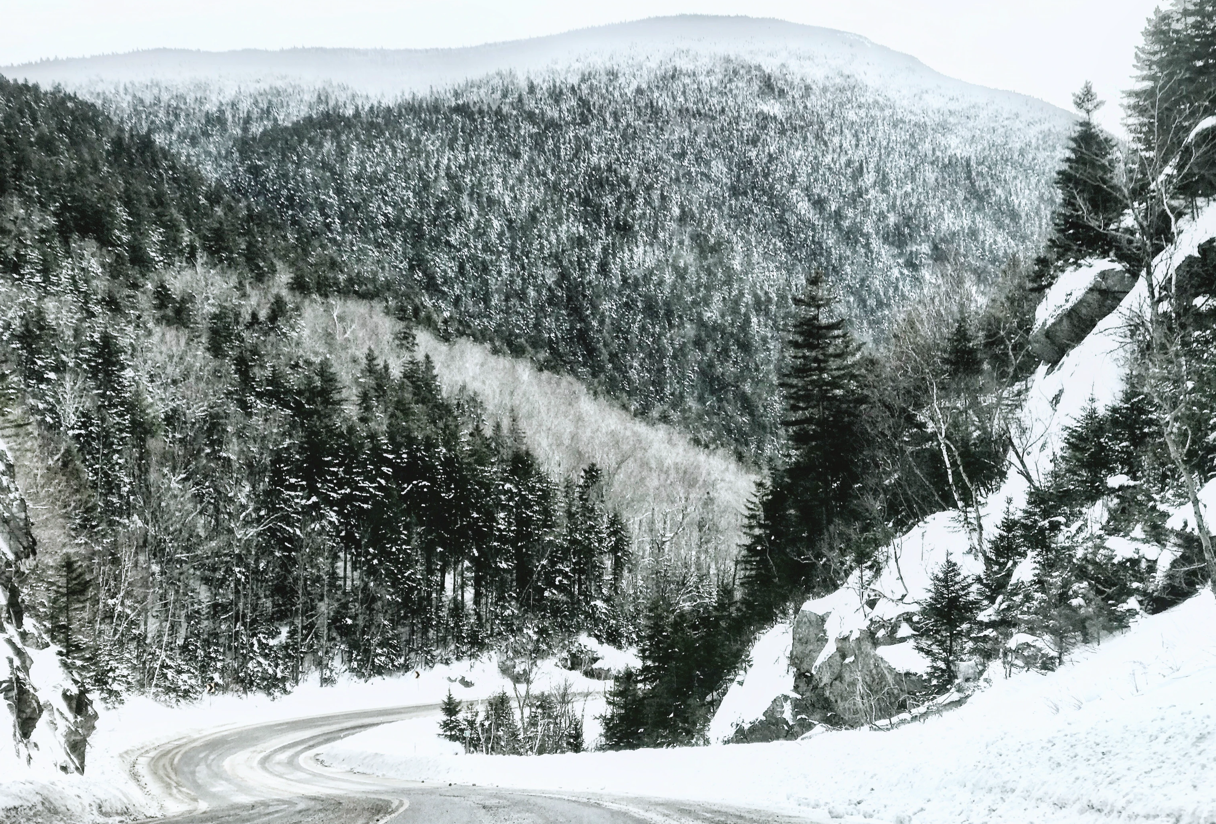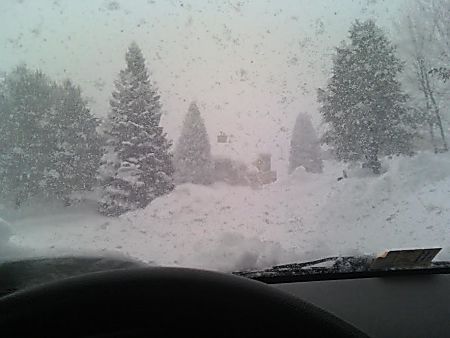Winter Driving in New Hampshire - How to Prepare
Prepping your car for winter will make you feel like a real Yankee in no time.

Prepping your car for winter will make you feel like a real Yankee in no time. Why? You quickly realize that if you break down by the side of the road in winter and you're unprepared, you could die.
That fact will inflame your independent and self-reliant spirit in no time.
Typically, the northern part of New Hampshire sees colder temperatures and greater snowfall during winter than the southern counties. That said, I've experienced temperatures as low as -19 °F on multiple — but rare — occasions in Monadnock and Cheshire counties.
I made the move to New Hampshire in 2013 and settled on Crotched Mountain in Bennington. I arrived about a month and half before winter.

Before moving up I had fun researching tips on how to prepare my vehicle for winter. Since then I've learned a few tricks from experience. I hope you'll find this information useful.
Under the Hood: Checks to Do Before Snow Falls
You can spend between $10-$15 to get some simple automotive tools from Amazon that will help you prepare for winter.
Checking Your Brake Fluid and Radiator Fluid
I use:
The brake fluid tester is a pen-like device: remove the cap, and stick the protruding metal pins into your brake fluid reservoir. You'll get an instant readout of whether your fluid needs to be changed.
Next, take the hydrometer and use it to extract some radiator fluid out of the reservoir. The gauge on the hydrometer will tell you if your radiator fluid is due for a change.
Sprucing Your Battery Up
In fall, I clean my battery terminals and lubricate them to sustain a better connection. I also place felt washers around the base of the terminals.
I carry a socket wrench in my car with the right fitting for removing the terminal connectors - just in case my battery dies on the road and needs to be replaced.
I should note here that I've never had my car battery fail in winter here, but it has ailed on occasion during heat waves.
Snow Tires Are a Must
Don't try to wing winter with all seasons on. Having snow tires is essential. This is true whether you're living in a rural area or in a New Hampshire city like Portsmouth, Manchester, or Concord.
Each winter there are news stories about fatal accidents occurring on well-traveled north-south highways like I-93 and I-81.
Less-traveled roads that connect rural towns are sometimes not salted. In fact, you'll see road signs in some cases warning that a particular stretch of road does not get salted or gets minimal treatment.
Studs or No Studs?
This is going to come down to preference. When I first arrived, a friend of mine in Vermont advised me to get studded tires. I followed her advice and was glad I did.
I opted for studded Firestone WinterForce tires. And I noticed that I was one of the few drivers around with studs.

Driving on Crotched Mountain. Piece of cake!
With those badass tires I was able to zip up and down the snow mountain in my 2-door hatchback, passing pickup trucks that were stuck at the bottom.
The WinterForce tires had an aggressive tread and provided great traction.
The new generation of WinterForce tires, unfortunately, doesn't have as aggressive of a tread.
Four years later, when my snows wore out, I passed on Firestone and opted for Nokian tires -- a Finnish brand. Specifically I got theHakkapelliita 8s with studs.
Tip: Local tires stores don't have the variety you're used to seeing in metropolitan areas. You can order your snows online and take them to a local mechanic to get them mounted.
The Nokian tires are designed in a way that enables a far greater number of studs to be inserted. The design also provides rear cushioning for the studs, so that the tires are much quieter than studded Firestones when driving on asphalt.
Be Aware: Not All Drivers Use Snows
Some New Hampshire drivers try to cut costs by driving on all seasons during winter. If those all seasons are near the end of their tread life, that makes them even more iffy on the road.
This is one reason you should remain alert while driving during winter, so you can take proactive action if necessary.
Getting Your Snows On
When you get your snows on, be sure to get the usual mechanic check for winter.
Also: be aware that Walmart's automotive department will not mount tires that don't perfectly match your vehicle's recommended specs.
So if, like me, you're using snows that are a size up, get them mounted at a local garage.
Buy a Portable Air Compressor
When the really cold weather hits, you may find you have to inflate your tires back up to the recommended PSI.
I usually have to do this a few times during winter. I recommend that you get a portable air compressor. You can get one from Amazon for $35.

There are 2 reasons you'll be glad you did.
- If you're away from home, or traveling at night, you may be miles away from a gas station. Or, the nearest gas station in a rural area may not have air compressors. Having your own will provide you with a convenient way to handle inflation yourself.
- Commercial air compressors at gas stations can fail in severe winter weather. I experienced this when, during an Arctic weather event, I checked the air in my brand new Hakkapelliitas. The air machine went bonkers, sucked all the air out of my 2 rear tires and froze to one of the stems, breaking it.
Which brings me to my next tip.
What About AAA?
I have a platinum membership to AAA and called them when the beserk air machine deflated my tires.
However, on this night of severe weather, I found out that the regional AAA office was ill-prepared to handle calls.
It wasn't just that they were experiencing a higher volume of calls. It turned out they had fired one of their main providers over (allegedly) their refusal to service one additional town.
AAA had given me an initial (long) time frame for the arrival of the tow truck. When that time passed, and I called for an update, they admitted they had never sent anyone out in the first place, and didn't know who to send out.
I felt I had to add some polite pressure to get anyone to come out. (I reminded them of the -6°F temperatures outside.)
Self-reliance is part of rural life here.
The folks at AAA seemed disorganized, inexperienced, and hapless.
To be fair, I had never experienced that kind of goofiness from AAA before nor have I since. I have used them several times since and they've been completely reliable. And I continue to maintain my platinum membership.
However, I recommend you make some local connections before winter in the event AAA cannot help you within a reasonable time frame.
- Make a connection to a local tow truck driver who's available 24/7 and get his number.
- As a backup, connect with new friends and agree to help each other out if one of you gets stranded by the side of the road.
Laying in Supplies
You'll want to kit your trunk out with some basic emergency and winter supplies like:
- Emergency flashers
- Jumper cables
- Battery-powered lantern and/or flashlights
- Extra batteries
- Cell phone charger battery
I also stock in:
- A mylar blanket and a wool blanket or two
- Food (e.g. peanut butter crackers, granola bars) (in case of an hours-long winter roadside issue)
- Extra pair of boots and socks (in case mine get wet)
- Extra layers
- Hot Hands
- Winter gloves
- Water
I carry water in a small rucksack, along with extra batteries. To prevent the water from freezing (or the batteries from dying) I keep the rucksack in the house and take it with me when traveling.
GPS Is a Must
It's easy to get incredibly lost in rural New Hampshire. It's not uncommon for roads to have street signs missing. And after miles of driving underneath the brilliant pine-framed blue skies, every road starts to look the same.
New Hampshire is a low-population-density state. You may be used to navigating by familiar sights: like the 7-11 near your home or Burger King across the highway. Realize that you can drive for hours in rural New Hampshire and not see a single 7-11.
Do yourself a favor. If your car didn't come with a GPS system, buy one before you arrive.
You can get a Tom-Tom for as little as $99 from Walmart or Amazon.
One handy feature is the "Point of Interest Near Me." You can use it to quickly find the closest gas station, hotel, grocery store, or other facility.
Driving After a Snowstorm
My trick for driving in winter (and having zero accidents) is this: after a snowstorm, drive out to the closest main road. In a rural area, this is going to be a two-lane "highway" (known elsewhere as a winding country road).
Wait until there's no traffic (which is actually most of the time). Turn out onto the road. Brake repeatedly and get a feel for what you're sensing under your tires.
If there's fresh snow, but your car is sliding gratuitously, there's ice under the snow. You'll be able to tell that the type of sliding is not controllable.
(Moderate sliding from hitting the brakes too hard is normal.)
I've only encountered this type of ice-under-snow phenomenon about 3-4 times since I've been here. My rule is: Turnaround and go back home. Wait for the road to be sanded.
As long as you're not on a major north-south artery (like 89 or 93) don't hesitate to drive as slowly as you feel you need to. You'll find that New Hampshire folks are patient and don't mind.
Now, if you've got a driver from Massachusetts behind you, that's another thing . . .